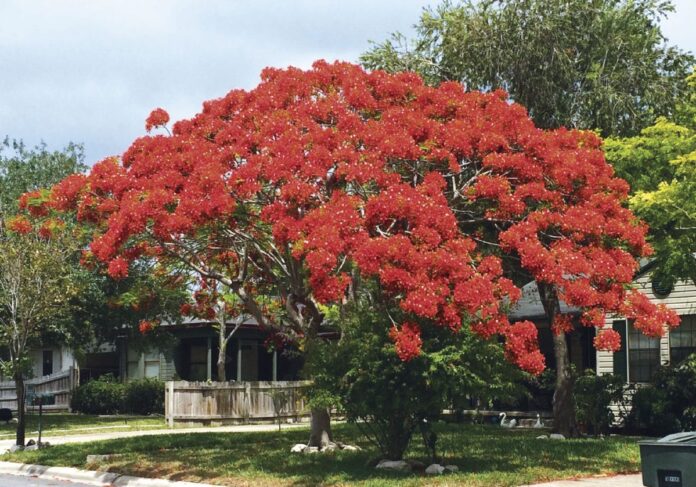BY LORI MURRAY
Few trees in the Valley are more beautiful than the Royal Poinciana. They burst into spring with a blast of red-orange color that nearly ignites the areas they populate. They are spectacular in full bloom and their fine, soft, delicate leaflets provide dense but dappled shade during the remainder of the growing season. The trees are often broader than they are tall, growing about 40 feet high and 60 feet wide. The crown is symmetrical and spreading, and the tree is typically multi-trunked. It takes full sun and will do well in most soils – even the clay found locally. It should not be planted closer than ten feet from a sidewalk or pavement since its large surface roots often grow beneath them and can destroy them.
Royal Poincianas should be well-watered until established but don’t require much water after that. You often see them in dry vacant lots, just bursting with flowers. Grass grows poorly under these trees because though feathery, the shade of an adult tree is dense and doesn’t allow enough sun to nourish the grass. Early pruning is required to encourage the development of branches which are well attached to the trunk. This will help compensate for the weak wood. Train the tree so that the main limbs are located 8 – 12 feet from the ground to allow for adequate clearance as the limbs tend to droop.
The Poinciana’s flowers are huge, with four spreading scarlet or orange-red petals up to 3 inches long and a fifth upright petal called the standard which is slightly larger and spotted with yellow and white. Seed pods are very hard, dark brown, and very large. They can be two feet long and several inches wide.
The individual seeds, however, are small. The tree is best propagated from the seed contained in the pod. Soak them in warm water for at least 24 hours and plant in warm, moist soil in a semi-shaded, sheltered place. Frequently, the pods will fall to the ground and break, and the seeds that fall into fertile sheltered soil will sprout without any help from the gardener! The downside of the Poinciana is that it is always shedding. The tiny leaflets drop from the foliage constantly and at certain times of the year create piles that need to be swept up. For this reason it is best planted away from areas that see frequent outdoor use and away from water features that could be clogged by a build-up of delicate but nasty debris. Since the tree is best viewed from a distance rather than from underneath, this should not be a problem. Poincianas drop all their foliage in the fall and, since they are a tropical plant, are sensitive to very cold weather. Even if they die down during an unusually cold Valley winter, they usually come back in the spring to please us all with their flamboyant display.
For more information: http://edis.ifas.ufl.edu





